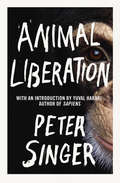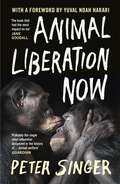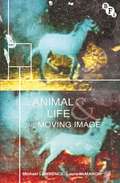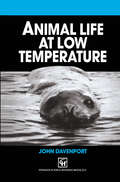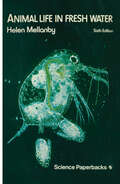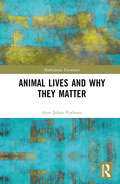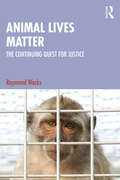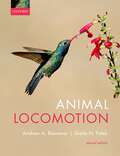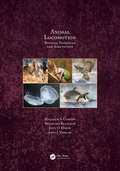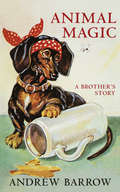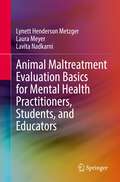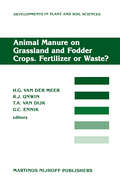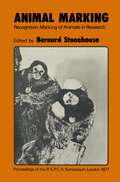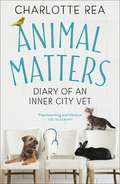- Table View
- List View
Animal Liberation: Towards An End To Man's Inhumanity To Animals
by Peter SingerHow should we treat non-human animals? In this immensely powerful and influential book (now with a new introduction by Sapiens author Yuval Noah Harari), the renowned moral philosopher Peter Singer addresses this simple question with trenchant, dispassionate reasoning. Accompanied by the disturbing evidence of factory farms and laboratories, his answers triggered the birth of the animal rights movement.'An extraordinary book which has had extraordinary effects... Widely known as the bible of the animal liberation movement' Independent on SundayIn the decades since this landmark classic first appeared, some public attitudes to animals may have changed but our continued abuse of animals in factory farms and as tools for research shows that the underlying ideas Singer exposes as ethically indefensible are still dominating the way we treat animals. As Yuval Harari’s brilliantly argued introduction makes clear, this book is as relevant now as the day it was written.
Animal Liberation Now
by Peter SingerThe definitive case for radically rethinking humanity's relationship with other animals - for the good of us all. 'The book that had the most impact on me' JANE GOODALL'Probably the single most influential document in the history of ... animal welfare' GUARDIANIn 1975, Animal Liberation started a global movement when it uncovered the abuse of animals in factory farms and laboratories and showed these horrific practices to be morally indefensible. In the decades since, science has vindicated Peter Singer’s arguments about animal sentience, plant-based diets have become mainstream and his landmark book has changed millions of minds. And yet, for animals, the situation has grown worse.Fully rewritten for the twenty-first century, Animal Liberation Now reveals these new developments and refines its arguments to address the pressing problems of today, including the impact of meat consumption on the climate emergency and the spread of lethal new viruses. A book of galvanising power and importance, it shows that the need to radically rethink our relationship with animals is more pressing than ever.'Will motivate a new generation of readers who are resolutely committed to creating a just society for all' JOAQUIN PHOENIX'The indispensable foundational text for the movement, new and updated' J. M. COETZEE'One the most important books of the last 100 years' ECOLOGIST
Animal Life and the Moving Image
by Michael Lawrence Laura McMahonFrom the proto-cinematic sequencing of animal motion in the nineteenth century to the ubiquity of animal videos online, the histories of animal life and the moving image are enigmatically interlocked. Animal Life and the Moving Image is the first collection of essays to offer a sustained focus on the relations between screen cultures and non-human animals. The volume brings together some of the most important and influential writers working on the non-human animal's significance for cultures and theories of the moving image. It offers innovative analyses of the representation of animals across a wide range of documentary, fiction, mainstream and avant-garde practices, from early cinema to contemporaryuser-generated media. Individual chapters consider King Kong, The Birds, The Misfits, The Cove, Grizzly Man and Microcosmos, the work of Sergei Eisenstein, Robert Bresson, Malcolm Le Grice, Peter Greenaway, Carolee Schneemann and Isabella Rossellini, and YouTube stars Christian the lion and Maru the cat.
Animal Life and the Moving Image
by Michael Lawrence Laura McMahonFrom the proto-cinematic sequencing of animal motion in the nineteenth century to the ubiquity of animal videos online, the histories of animal life and the moving image are enigmatically interlocked. Animal Life and the Moving Image is the first collection of essays to offer a sustained focus on the relations between screen cultures and non-human animals. The volume brings together some of the most important and influential writers working on the non-human animal's significance for cultures and theories of the moving image. It offers innovative analyses of the representation of animals across a wide range of documentary, fiction, mainstream and avant-garde practices, from early cinema to contemporaryuser-generated media. Individual chapters consider King Kong, The Birds, The Misfits, The Cove, Grizzly Man and Microcosmos, the work of Sergei Eisenstein, Robert Bresson, Malcolm Le Grice, Peter Greenaway, Carolee Schneemann and Isabella Rossellini, and YouTube stars Christian the lion and Maru the cat.
Animal Life at Low Temperature
by John DavenportTo humans, cold has a distinctly positive quality. 'Frostbite', 'a nip in the air', 'biting cold', all express the concept of cold as an entity which attacks the body, numbing and damaging it in the process. Probably the richness of descriptive English in this area stems from the early experiences of a group of essentially tropical apes, making their living on a cold and windswept island group half way between the Equator and the Arctic. During a scientific education we soon learn that there is no such thing as cold, only an absence of heat. Cold does not invade us; heat simply deserts. Later still we come to appreciate that temperature is a reflection of kinetic energy, and that the quantity of kinetic energy in a system is determined by the speed of molecular movement. Despite this realization, it is difficult to abandon the sensible prejudices of palaeolithic Homo sapiens shivering in his huts and caves. For example; appreciating that a polar bear is probably as comfortable when swimming from ice floe to ice floe as we are when swimming in the summer Mediterranean is not easy; understanding the thermal sensa tions of a 'cold-blooded' earthworm virtually impossible. We must always be wary of an anthropocentric attitude when considering the effects of cold on other species.
Animal Life in Fresh Water: A Guide to Fresh-Water Invertebrates
by Helen Mellanbyby Professor L. E. Eastham Formerly Professor of Zoology in the University of Sheffield Most books are written with the intention of supplying some particular need, but few end with such single purpose. Mrs. Mellanby's is no exception, for while the author planned this work to serve as a guide to the school pupil, which function it fulfils in an admirable way, it will also prove of value to the teacher, the university student and the amateur naturalist. While it may be argued that it is not the function of the Uni versities to teach Natural History in the commonly accepted sense, it will always be the aim of Zoologists to know more about animals, what they are and do, where they live and why they live in particular environments. It is unfortunate, in view of the fact that the majority of students of Zoology enter the teaching pro fession, that the increasing load of instruction in morphology, physiology, cytology, genetics, evolution and the like frequently makes a personal study of animal life in relation to environment almost impossible. The fortunate ones visit the sea for a fort night's course in Marine Ecology; the others take posts in schools without even this respite and set about converting their academic learning to a school curriculum. The result is an undesirable and often slavish imitation of university method in the school class room.
Animal Lives and Why They Matter (Multispecies Encounters)
by Arne Johan VetlesenThis book engages with the changing ways in which we, as a society and culture, look upon and interact with animals, stressing how much animals differ among themselves. An invitation to appreciate the peculiar role of animals in telling important if uncomfortable truths about who we are and where we are heading – namely, towards a world so much poorer in cultural, moral, and biological diversity – as a result of the ongoing decimation of so many other species. Drawing on a variety of thought ranging from that of Midgley, Plumwood, and Murdoch to Levinas, Derrida, and Habermas, from ecophilosophers to conservation biologists, Animal Lives and Why They Matter asks how we have come to this, and what an alternative, less destructive approach to our now precarious coexistence with animals might look like. Spanning the disciplines of philosophy, psychology, and anthropology, this enquiry into various cross-species relationships and encounters will appeal to scholars and students across the humanities and social sciences with interests in philosophy, ethics, human-animal interaction, and environmental thought.
Animal Lives and Why They Matter (Multispecies Encounters)
by Arne Johan VetlesenThis book engages with the changing ways in which we, as a society and culture, look upon and interact with animals, stressing how much animals differ among themselves. An invitation to appreciate the peculiar role of animals in telling important if uncomfortable truths about who we are and where we are heading – namely, towards a world so much poorer in cultural, moral, and biological diversity – as a result of the ongoing decimation of so many other species. Drawing on a variety of thought ranging from that of Midgley, Plumwood, and Murdoch to Levinas, Derrida, and Habermas, from ecophilosophers to conservation biologists, Animal Lives and Why They Matter asks how we have come to this, and what an alternative, less destructive approach to our now precarious coexistence with animals might look like. Spanning the disciplines of philosophy, psychology, and anthropology, this enquiry into various cross-species relationships and encounters will appeal to scholars and students across the humanities and social sciences with interests in philosophy, ethics, human-animal interaction, and environmental thought.
Animal Lives Matter: The Continuing Quest for Justice
by Raymond WacksAnimal Lives Matter provides a comprehensive analysis of the legal, philosophical, and ethical aspects of animal rights. It argues that the subject extends beyond the matter of our obligations towards animals, to include our wider responsibilities for protecting the environment. Drawing on numerous moral, political, legal, religious, and philosophical theories including utilitarianism, deontology, rights theory, social contractarianism, and the capabilities approach, the author meticulously examines the questions of sentience, speciesism, personhood, and human exceptionalism. Lucid, nuanced, and academically rigorous, this important book will be an essential resource for scholars of law, politics, philosophy, ethics, as well as policy makers and the general reader.
Animal Lives Matter: The Continuing Quest for Justice
by Raymond WacksAnimal Lives Matter provides a comprehensive analysis of the legal, philosophical, and ethical aspects of animal rights. It argues that the subject extends beyond the matter of our obligations towards animals, to include our wider responsibilities for protecting the environment. Drawing on numerous moral, political, legal, religious, and philosophical theories including utilitarianism, deontology, rights theory, social contractarianism, and the capabilities approach, the author meticulously examines the questions of sentience, speciesism, personhood, and human exceptionalism. Lucid, nuanced, and academically rigorous, this important book will be an essential resource for scholars of law, politics, philosophy, ethics, as well as policy makers and the general reader.
Animal Locomotion
by Andrew Biewener Sheila PatekAnimals have evolved remarkable biomechanical and physiological systems that enable their rich repertoire of motion. Animal Locomotion offers a fundamental understanding of animal movement through a broad comparative and integrative approach, including basic mathematics and physics, examination of new and enduring literature, consideration of classic and cutting-edge methods, and a strong emphasis on the core concepts that consistently ground the dizzying array of animal movements. Across scales and environments, this book integrates the biomechanics of animal movement with the physiology of animal energetics and the neural control of locomotion. This second edition has been thoroughly revised, incorporating new content on non-vertebrate animal locomotor systems, studies of animal locomotion that have inspired robotic designs, and a new chapter on the use of evolutionary approaches to locomotor mechanisms and performance.
Animal Locomotion: Physical Principles and Adaptations
by Malcolm S. Gordon Reinhard Blickhan John O. Dabiri John J. VidelerAnimal Locomotion: Physical Principles and Adaptations is a professional-level, state of the art review and reference summarizing the current understanding of macroscopic metazoan animal movement. The comparative biophysics, biomechanics and bioengineering of swimming, flying and terrestrial locomotion are placed in contemporary frameworks of biodiversity, evolutionary process, and modern research methods, including mathematical analysis. The intended primary audience is advanced-level students and researchers primarily interested in and trained in mathematics, physical sciences and engineering. Although not encyclopedic in its coverage, anyone interested in organismal biology, functional morphology, organ systems and ecological physiology, physiological ecology, molecular biology, molecular genetics and systems biology should find this book useful.
Animal Locomotion: Physical Principles and Adaptations
by Malcolm S. Gordon Reinhard Blickhan John O. Dabiri John J. VidelerAnimal Locomotion: Physical Principles and Adaptations is a professional-level, state of the art review and reference summarizing the current understanding of macroscopic metazoan animal movement. The comparative biophysics, biomechanics and bioengineering of swimming, flying and terrestrial locomotion are placed in contemporary frameworks of biodiversity, evolutionary process, and modern research methods, including mathematical analysis. The intended primary audience is advanced-level students and researchers primarily interested in and trained in mathematics, physical sciences and engineering. Although not encyclopedic in its coverage, anyone interested in organismal biology, functional morphology, organ systems and ecological physiology, physiological ecology, molecular biology, molecular genetics and systems biology should find this book useful.
Animal Locomotion
by Graham Taylor Michael S. Triantafyllou Cameron TropeaThe physical principles of swimming and flying in animals are intriguingly different from those of ships and airplanes. The study of animal locomotion therefore holds a special place not only at the frontiers of pure fluid dynamics research, but also in the applied field of biomimetics, which aims to emulate salient aspects of the performance and function of living organisms. For example, fluid dynamic loads are so significant for swimming fish that they are expected to have developed efficient flow control procedures through the evolutionary process of adaptation by natural selection, which might in turn be applied to the design of robotic swimmers. And yet, sharply contrasting views as to the energetic efficiency of oscillatory propulsion – especially for marine animals – demand a careful assessment of the forces and energy expended at realistic Reynolds numbers. For this and many other research questions, an experimental approach is often the most appropriate methodology. This holds as much for flying animals as it does for swimming ones, and similar experimental challenges apply – studying tethered as opposed to free locomotion, or studying the flow around robotic models as opposed to real animals. This book provides a wide-ranging snapshot of the state-of-the-art in experimental research on the physics of swimming and flying animals. The resulting picture reflects not only upon the questions that are of interest in current pure and applied research, but also upon the experimental techniques that are available to answer them.
Animal Magic: A Brother's Story
by Andrew Barrow'Your brother looked healthy, happy, natural. But everything else about him is extremely odd. Not faintly odd. Extremely odd. Except in appearance. He's the opposite of you.' Quentin CrispAt the age of twenty-two, the youngest of five brothers, Jonathan Barrow, was killed with his fiancée in a car crash. He left behind the manuscript of a novel, The Queue, in which, among other things, he prophesied his own death. The story of a boy and a dachshund, populated by a kaleidoscopic menagerie of people and animals and an array of anthropomorphic in-betweens, The Queue is a vivid and irreverent portrayal of the world in which Jonathan and his awe-struck older brother Andrew were raised. Jonathan and his book form the framework of a remarkable study of a young man's inner and outer effervescence, his family, England and high and low society in the Swinging Sixties. Filled with fascinating and fantastical anecdotes, Animal Magic documents a heady and peripatetic childhood in Lancashire, the Lake District and Wiltshire, misadventures at home and school, and the early working life of the two brothers, on the lower rungs of show business, backstage at Claridge's, and finally in advertising. This spellbinding elegy negotiates love affairs, family tensions, exhibitions, publishers' rejections and precarious living in a flat in Tite Street, Chelsea. Punctuated with excerpts from The Queue and Jonathan's other bizarre and brilliant writings, Animal Magic is a book bursting with humour, wit and pathos and featuring an outlandish cast of characters, from an eccentric father, a mischievous family dog and a down-and-out ex-schoolmaster to curious stars of Swinging London like Mick Jagger and Tommy Cooper. It is a memoir unlike any other.
Animal Maltreatment Evaluation Basics for Mental Health Practitioners, Students, and Educators
by Lynett Henderson Metzger Laura Meyer Lavita NadkarniThis book provides a brief introduction to the growing field of animal maltreatment evaluation and treatment, with a special emphasis on clinical training from a forensic psychology perspective. Geared toward mental health practitioners, students, and educators, this broad overview focuses on foundational legal concepts, applications in clinical and psycholegal settings, and emerging perspectives on effective evaluation and treatment. The authors provide practical guidance around “real world” scenarios through the use of clinical case vignettes, highlighting the complexities and need for culturally- and psychologically-informed care in these cases. Key topics include forensic animal maltreatment evaluations (or FAMEs); implications for best practices; challenges for providers, trainees, and supervisors; and future directions for the field.
Animal Management and Welfare in Natural Disasters
by James Sawyer Gerardo HuertasThe devastating impacts of natural disasters not only directly affect humans and infrastructure, but also animals, which may be crucial to the livelihoods of many people. This book considers the needs of animals in the aftermath of disasters and explains the importance of looking to their welfare in extreme events. The authors explore how animals are affected by specific disaster types, what their emergency and subsequent welfare needs are and the appropriate interventions. They describe the key benefits of management of animals to populations and discuss preventative measures that can be taken to reduce risk and build resilience. They also include a summary of recent debates and public policy advances on animals in disasters. The book covers livestock, companion and wild animals, with case studies to show how the concepts can be put into practice. It provides a standalone text for students of disaster studies and management as well as professionals and NGOs who require an entry-level introduction to the subject.
Animal Management and Welfare in Natural Disasters
by James Sawyer Gerardo HuertasThe devastating impacts of natural disasters not only directly affect humans and infrastructure, but also animals, which may be crucial to the livelihoods of many people. This book considers the needs of animals in the aftermath of disasters and explains the importance of looking to their welfare in extreme events. The authors explore how animals are affected by specific disaster types, what their emergency and subsequent welfare needs are and the appropriate interventions. They describe the key benefits of management of animals to populations and discuss preventative measures that can be taken to reduce risk and build resilience. They also include a summary of recent debates and public policy advances on animals in disasters. The book covers livestock, companion and wild animals, with case studies to show how the concepts can be put into practice. It provides a standalone text for students of disaster studies and management as well as professionals and NGOs who require an entry-level introduction to the subject.
Animal Manure: Agricultural and Biotechnological Applications (Soil Biology #64)
by Shubhangi Mahajan Ajit VarmaThis book covers the basics of animal manure, or animal dung, and highlights its applications in agriculture and biotechnology. The reader is given a comprehensive overview of the different types of animal manure. Although animal manure can cause environmental problems, e.g., when slurry pollutes rivers or burnt dung pollutes air, the book emphasizes the fact that animal dung is by no means a waste product. Animal manure is a valuable organic fertilizer that has a positive impact on soil conditions and helps save on chemical fertilizers. It is also a source of energy and can be either be used as fuel or converted into biogas through methanization. Old-age practices such as the use of dried dung as insulating material, or burnt dung as mosquito repellent are also taken up.With the increasing focus on the UN Sustainable Development Goals (SDGs), this book offers ideas and solutions related to SDG 2 Zero Hunger and SDG 15 Life on Land. The book will not only be an interesting read for students and researchers in the field of agriculture, but will also appeal to scientists working on waste management, organic manure production or in the paper industry.
Animal Manure on Grassland and Fodder Crops.Fertilizer or Waste?: Proceedings of an International Symposium of the European Grassland Federation, Wageningen, The Netherlands, 31 August–3 September 1987 (Developments in Plant and Soil Sciences #30)
by H. G. Van Der Meer R. J. Unwin T. A. Van Dijk G. C. EnnikOn the occasion of its twenty-fifth anniversary, in 1985, the Netherlands Society for Grassland and Fodder Crops (NVWV) agreed to organize an International Symposium on a topic related to intensive grass and fodder production systems. The theme selected was "Animal manure on grassland and fodder crops: Fertilizer or waste?" This Symposium was organized under the auspices of the European Grassland Federation and held at the International Agricultural Centre in Wageningen from 31 August to 3 September 1987. The problems connected with the disposal of animal waste have received much attention in recent years, especially in regions with intensive animal of animal manure per hectare agricul husbandry. Whereas the production tural land increased strongly, the need for it decreased because of the introduction of cheap inorganic fertilizers which are easier to handle and have a more reliable effect on crop growth. As a consequence, many farmers dispose of animal manure as cheaply as possible, whilst avoiding damage to grassland and crops and paying little attention to effective use of the plants nutrients contained in the manure. Present practices of manure handling and application often lead to environmental problems. The rise in awareness of these problems renewed interest in possibilities to improve the utilization of nutrients from animal manure in crop production. Research on this topic has been stimulated in many countries during the last decade and the aim of this Symposium was to review and assess present-day knowledge.
Animal Manure Recycling: Treatment and Management
by Sven G. Sommer Morten L. Christensen Thomas Schmidt Lars Stoumann JensenA rapidly changing and expanding livestock and poultry production sector is causing a range of environmental problems on local, regional and global scales. Animal Manure Recycling: Treatment and Management presents an accessible overview of environmentally friendly technologies for managing animal manure more efficiently and in a sustainable manner. The book describes the physical and chemical characteristics of animal manure and microbial processes, featuring detailed examples and case studies showing how this knowledge can be used in practice. Readers are introduced to the sustainable use of animal manure for crop fertilisation and soil amelioration. Environmentally friendly technologies for reducing emissions of ammonia, odour and the greenhouse gases nitrous oxide and methane are presented, and reduction of plant nutrient losses using separation technologies is introduced. Finally and most importantly, the book describes methods to commercialise and transfer knowledge about innovations to end-users. Topics covered include: Regulation of animal manure management Manure organic matter: characteristics and microbial transformations Greenhouse gas emissions from animal manures and technologies for their reduction Technologies and logistics for handling, transport and distribution of animal manures Bioenergy production Animal manure residue upgrading and nutrient recovery in bio-fertilisers Life cycle assessment of manure management systems Innovation in animal manure management and recycling Animal Manure Recycling: Treatment and Management presents state-of-the-art coverage of the entire animal manure chain, providing practical information for engineers, environmental consultants, academics and advanced students involved in scientific, technical and regulatory issues related to animal manure management.
Animal Manure Recycling: Treatment and Management
by Sven G. Sommer Morten L. Christensen Thomas Schmidt Lars Stoumann JensenA rapidly changing and expanding livestock and poultry production sector is causing a range of environmental problems on local, regional and global scales. Animal Manure Recycling: Treatment and Management presents an accessible overview of environmentally friendly technologies for managing animal manure more efficiently and in a sustainable manner. The book describes the physical and chemical characteristics of animal manure and microbial processes, featuring detailed examples and case studies showing how this knowledge can be used in practice. Readers are introduced to the sustainable use of animal manure for crop fertilisation and soil amelioration. Environmentally friendly technologies for reducing emissions of ammonia, odour and the greenhouse gases nitrous oxide and methane are presented, and reduction of plant nutrient losses using separation technologies is introduced. Finally and most importantly, the book describes methods to commercialise and transfer knowledge about innovations to end-users. Topics covered include: Regulation of animal manure management Manure organic matter: characteristics and microbial transformations Greenhouse gas emissions from animal manures and technologies for their reduction Technologies and logistics for handling, transport and distribution of animal manures Bioenergy production Animal manure residue upgrading and nutrient recovery in bio-fertilisers Life cycle assessment of manure management systems Innovation in animal manure management and recycling Animal Manure Recycling: Treatment and Management presents state-of-the-art coverage of the entire animal manure chain, providing practical information for engineers, environmental consultants, academics and advanced students involved in scientific, technical and regulatory issues related to animal manure management.
Animal Matters: Diary of an Inner City Vet
by Charlotte Rea'Heartwarming and hilarious' Telegraph'With as many horrifying stories as heart-warming ones, this is a fascinating look at the year in the life of a vet at a London animal charity hospital. There are some proper belly laughs as well as some insights that will truly stick with you.' - Alexandra Heminsley, GraziaAn unusual 'dalmation', a TV star with cancer, an out of control budgie. Charlotte Rea has seen them all, and more. Animal Matters is Charlotte's diary of real-life cases written during a one year of her work as a veterinary surgeon in a 24-hour inner-city London animal charity. The diary reveals the reality of working as a vet, how it can be both emotional and amusing, one minute you can be consoling an owner on the loss of their much-loved pet, the next trying to catch an escaped budgie. Charlotte mixes deeply sad moments with amusing and unimaginable ones along with more detailed accounts and reflections back on her training and the experiences she has come up against over the decade since she graduated. Throughout the book you will get to know both the animals and the people and how close the bond between us can be. Charlotte also discusses contemporary issues in veterinary medicine such as animal euthanasia, RSPCA welfare cases, mental health issues within the veterinary profession, ethical concerns around pedigree dog breeding and the laws on dangerous dogs. Animal Matters is a moving and heartwarming book about the unconditional love between animals and humans.
